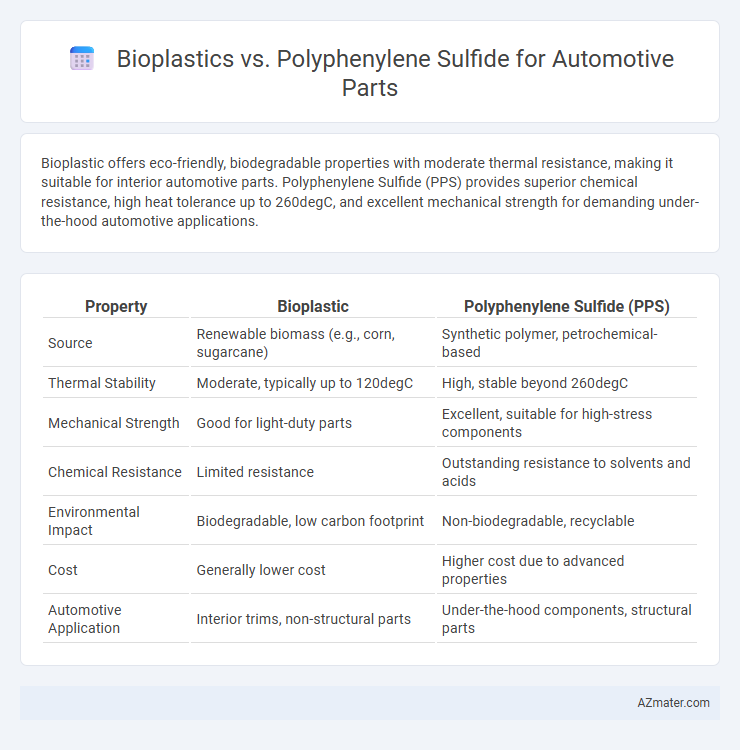Bioplastic offers eco-friendly, biodegradable properties with moderate thermal resistance, making it suitable for interior automotive parts. Polyphenylene Sulfide (PPS) provides superior chemical resistance, high heat tolerance up to 260degC, and excellent mechanical strength for demanding under-the-hood automotive applications.
Table of Comparison
| Property | Bioplastic | Polyphenylene Sulfide (PPS) |
|---|---|---|
| Source | Renewable biomass (e.g., corn, sugarcane) | Synthetic polymer, petrochemical-based |
| Thermal Stability | Moderate, typically up to 120degC | High, stable beyond 260degC |
| Mechanical Strength | Good for light-duty parts | Excellent, suitable for high-stress components |
| Chemical Resistance | Limited resistance | Outstanding resistance to solvents and acids |
| Environmental Impact | Biodegradable, low carbon footprint | Non-biodegradable, recyclable |
| Cost | Generally lower cost | Higher cost due to advanced properties |
| Automotive Application | Interior trims, non-structural parts | Under-the-hood components, structural parts |
Introduction to Bioplastic and Polyphenylene Sulfide in Automotive Applications
Bioplastic, derived from renewable biomass sources like cornstarch and sugarcane, offers biodegradable and eco-friendly alternatives for automotive parts such as interior panels and trim. Polyphenylene sulfide (PPS) is a high-performance thermoplastic known for its excellent thermal stability, chemical resistance, and mechanical strength, making it ideal for under-the-hood components and electrical insulation. Both materials address sustainability and durability demands in automotive manufacturing, with bioplastics emphasizing environmental benefits and PPS ensuring high-performance functionality.
Material Composition and Structure Comparison
Bioplastic for automotive parts primarily consists of renewable polymers such as polylactic acid (PLA) or polyhydroxyalkanoates (PHA), characterized by a biodegradable and semi-crystalline structure that enables lower environmental impact. In contrast, Polyphenylene Sulfide (PPS) is a high-performance thermoplastic composed of aromatic sulfide polymers with a highly crystalline, rigid structure that provides exceptional thermal stability and chemical resistance. The distinct molecular compositions result in bioplastics offering sustainable alternatives with limited thermal durability, whereas PPS delivers superior mechanical strength and long-term performance in demanding automotive applications.
Mechanical Properties and Performance
Bioplastic materials offer lightweight and sustainable alternatives with moderate tensile strength and flexibility suitable for non-structural automotive parts, while polyphenylene sulfide (PPS) exhibits superior mechanical properties, including high thermal stability, excellent chemical resistance, and outstanding dimensional stability under stress. PPS's exceptional fatigue resistance and mechanical performance at elevated temperatures make it ideal for under-the-hood components requiring durability and precision. In contrast, bioplastics often require reinforcement to match PPS's rigidity and thermal endurance in demanding automotive applications.
Thermal Stability and Heat Resistance
Polyphenylene Sulfide (PPS) demonstrates superior thermal stability and heat resistance compared to bioplastics, making it highly suitable for automotive parts exposed to high temperatures. PPS maintains mechanical properties at temperatures up to 260degC, whereas most bioplastics degrade or lose strength well below 200degC. This thermal robustness of PPS ensures enhanced durability and safety in engine components, electrical housings, and under-the-hood applications.
Chemical Resistance and Durability
Polyphenylene sulfide (PPS) offers superior chemical resistance and durability compared to bioplastics, making it ideal for automotive parts exposed to harsh chemicals and high temperatures. While bioplastics provide environmental benefits, their lower thermal stability and susceptibility to chemical degradation limit their use in critical automotive applications. PPS withstands aggressive fluids and maintains mechanical integrity, ensuring long-term performance in demanding automotive environments.
Environmental Impact and Sustainability
Bioplastics offer a renewable alternative to traditional automotive materials by reducing carbon emissions and enhancing biodegradability, making them a key player in sustainable vehicle manufacturing. Polyphenylene Sulfide (PPS), while offering superior chemical resistance, thermal stability, and durability, poses environmental challenges due to its reliance on petrochemical sources and limited recyclability. Prioritizing bioplastics in automotive parts supports long-term environmental goals by lowering fossil fuel dependence and minimizing end-of-life waste, aligning with global sustainability initiatives.
Cost Analysis and Economic Viability
Bioplastic offers a lower initial cost and renewable sourcing compared to polyphenylene sulfide (PPS), which has higher material and processing expenses but superior thermal and chemical resistance suited for demanding automotive applications. Cost analysis reveals bioplastics reduce long-term environmental compliance costs, yet PPS's durability and performance justify its premium price in critical engine and under-the-hood components. Economic viability depends on production scale, with bioplastics favored for lightweight, non-structural parts and PPS dominating high-performance applications where material strength and longevity are paramount.
Processing and Manufacturing Considerations
Bioplastic offers easier processing with lower melting temperatures and biodegradability, making it suitable for injection molding processes in automotive parts. Polyphenylene sulfide (PPS) requires higher processing temperatures above 300degC and specialized equipment to maintain its thermal stability, ideal for high-performance under-the-hood components. Manufacturing with PPS ensures superior chemical resistance and dimensional stability, while bioplastics prioritize sustainability but may face limitations in mechanical strength and thermal endurance.
Application Case Studies in Automotive Parts
Bioplastic materials, such as polylactic acid (PLA) and polyhydroxyalkanoates (PHA), demonstrate promising applications in interior automotive parts like dashboards and door panels due to their biodegradability and reduced environmental impact. Polyphenylene sulfide (PPS) excels in under-the-hood components, including connectors and pump housings, thanks to its exceptional thermal stability, chemical resistance, and mechanical strength. Case studies from manufacturers like Ford and Toyota highlight PPS for high-performance engine parts, while companies such as BMW explore bioplastics for lightweight, sustainable interior components, balancing durability with eco-friendly material choices.
Future Trends and Innovations in Automotive Polymers
Bioplastic and polyphenylene sulfide (PPS) are shaping the future of automotive polymers by offering sustainable and high-performance options for automotive parts. Innovations in bioplastics focus on enhancing biodegradability and mechanical strength to reduce carbon footprints, while advancements in PPS emphasize heat resistance and chemical stability for demanding engine components. Emerging trends include hybrid composites combining bioplastics with PPS to optimize durability and sustainability in lightweight vehicle applications.

Infographic: Bioplastic vs Polyphenylene Sulfide for Automotive Part
 azmater.com
azmater.com